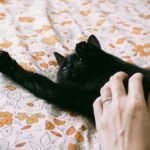Have you ever wondered if your beloved cat is truly happy, or if their quiet ways are signs of deep contentment? The truth is, cats are emotional creatures—sometimes even more complex than we realize. They might not wear their hearts on their sleeves, but their daily behaviors can reveal powerful clues about their emotional development. If you want to know if your feline friend is thriving and growing emotionally, watch for these surprising, inspiring daily patterns. It may just change how you see your cat forever.
Seeking Out Social Interaction

One of the most heartwarming signs of a cat’s emotional growth is when they actively seek out your company. Cats who have matured emotionally often choose to be in the same room as their human, even if they’re just lounging nearby. This is a far cry from the aloof stereotype we often hear about—emotionally secure cats crave gentle social contact. They might rub against your legs, hop onto your lap, or simply purr contentedly while you’re close. This daily pattern shows that your cat feels safe and values connection. It’s a huge leap from hiding under the bed or avoiding touch, and it’s a sign that trust is blossoming. If your cat greets you at the door or follows you around the house, cherish it—they’re showing you their growing affection.
Engaging in Playful Behavior

Play is not just about burning energy—it’s a signal of emotional well-being in cats. When a cat frequently initiates play, whether with toys, other pets, or even you, it’s a reflection of confidence and happiness. Mature cats might bat at a feather toy, chase a laser pointer, or even invent their own games with household objects. This playful spirit often emerges as cats grow more comfortable and self-assured. Engaging in play reduces stress and builds bonds, both with other cats and with humans. If you catch your cat zooming down the hallway or pouncing on a toy mouse, you’re witnessing emotional growth in action. Playful moments are their way of saying, “I feel good, and I trust my environment.”
Using Body Language to Communicate

Emotionally mature cats become adept at using their bodies to express themselves. You might notice subtle tail flicks, confident stretches, slow blinks, or kneading with their paws. These behaviors are not random—they are your cat’s language, telling you how they feel. For example, slow blinking is a cat’s way of showing trust and affection, while a relaxed, upright tail signals contentment. Cats who have grown emotionally will use these signals more often and more clearly. They learn that communication brings positive outcomes, such as petting, treats, or gentle words. By tuning into these daily patterns, you can better understand and respond to your cat’s needs, deepening your relationship.
Showing Curiosity and Exploration

A cat that regularly explores new areas of your home or investigates novel objects is demonstrating emotional growth. Curiosity is a sign that your cat feels secure enough to take risks. This might look like climbing onto shelves, sniffing new furniture, or watching birds from the window. An emotionally confident cat is less likely to hide and more likely to interact with their surroundings. You may even notice them “helping” you with chores or inspecting your groceries. This daily pattern shows that your cat is not only comfortable, but also eager to learn about their world. Curiosity is a driving force behind many feline adventures, and it’s a clear sign your cat is thriving.
Developing a Predictable Routine

Emotionally stable cats tend to settle into daily routines. They might wake you up at the same time every morning, expect meals at set hours, or claim a favorite sunny spot at midday. This predictability is a sign that your cat feels safe and secure in their environment. Routines help cats feel in control, which is vital for emotional health. Watching your cat stick to their chosen schedule can be both amusing and reassuring. It’s evidence that your cat trusts their home and the people in it. A well-established routine is often the result of emotional maturity and contentment.
Accepting Gentle Handling and Grooming

If your cat allows you to brush their fur, trim their claws, or check their ears without much fuss, it’s a sign of deep trust. Many cats are wary of handling, especially if they’ve had negative experiences in the past. When a cat grows emotionally, they become more tolerant of gentle touch. They might even start to enjoy grooming sessions, purring or nuzzling your hand. This acceptance means your cat associates you with safety and comfort. It also shows they’re moving past old fears and building new positive memories. Every purr and head bump during grooming is a small but powerful sign of emotional growth.
Responding to Their Name or Familiar Sounds

Cats who have formed strong emotional bonds often respond to their names or familiar phrases. You might notice your cat’s ears perking up when you call them, or they may trot over when they hear the treat jar rattle. This daily pattern suggests your cat feels connected to you and pays attention to your cues. It’s a form of communication and a sign of trust. When cats consistently respond to specific sounds, they’re showing that they recognize and value their relationship with you. It’s a simple, everyday miracle that reveals a deepening emotional connection.
Displaying Comfort with Guests or New Situations

Emotionally mature cats tend to handle new people or changes in their environment with calm curiosity rather than fear. If your cat ventures out to sniff a visiting friend or investigates a new piece of furniture without hiding, it’s a positive sign. This adaptability comes from feeling secure in their home base and confident in their own abilities. It may take time, but as cats grow emotionally, their tolerance for novelty increases. Instead of retreating at every unfamiliar sound, they’ll observe, assess, and often engage. This openness to new experiences is a hallmark of emotional resilience in cats.
Seeking Comfort During Stressful Times

When faced with loud noises, thunderstorms, or other stressors, emotionally growing cats may seek out your comfort rather than hiding away. They might curl up next to you, meow softly, or ask for gentle strokes. This behavior shows that your cat sees you as a source of safety and reassurance. It’s a powerful indicator of emotional maturity, as it means your cat has learned to trust you during vulnerable moments. By seeking comfort instead of isolation, your cat is showing a strong bond and a willingness to lean on you when they need support.
Demonstrating Affection in Unique Ways

Every cat has their own love language, and as they grow emotionally, their ways of showing affection become more apparent. Some cats will head-butt you, others may bring you “gifts,” and a few might simply curl up on your chest at night. These affectionate gestures are not random—they are deeply meaningful signs of trust and love. Over time, you’ll notice your cat developing their own rituals of affection, tailored just for you. Whether it’s a soft purr, a cheek rub, or a gentle paw on your hand, these daily patterns are the ultimate sign of emotional growth in your feline friend.

Linnea is a born and bred Swede but spends as much time as possible in Cape Town, South Africa. This is mainly due to Cape Town’s extraordinary scenery, wildlife, and atmosphere (in other words, because Cape Town is heaven on earth.) That being said, Sweden’s majestic forests forever hold a special place in her heart. Linnea spends as much time as she can close to the ocean collecting sea shells or in the park admiring puppies.






